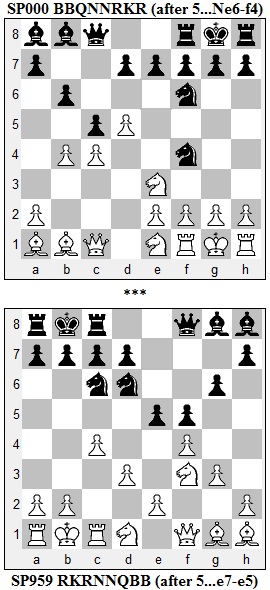HarryO and I decided to skip the initial phase of selecting a start position (SP) and go directly to an SP that had caught our attention in the first game. This was SP000 BBQNNRKR, aka the 'Extreme Barbecue' position. The name is derived from the BBQ formation on the first three files, aimed at the RKR formation on the last three files. Given the latent pressure of the three diagonal pieces against the bunched King and Rooks, it's an SP that could prove to be one of the trickiest for Black to navigate.
After that game, we played a second game starting with SP959 RKRNNQBB, the twin of SP000. Here the RKR on the first three files are under pressure from the QBB on the last three. Strategically, the only difference between SP000 and SP959 is the castling option. The top diagram below shows the position after the first five moves in the SP000 game, where HarryO played White. The bottom diagram shows the position after five moves in the SP959 game, where I had White. The moves and commentary for the two games are on HarryO's blog, Chess960 Jungle:-
HarryO subtitled SP000 'or SP960 depending on who you talk to'. He is referring to the common error that chess960 newcomers sometimes make, numbering the 960 SPs starting with '1' rather than with '0'. In that case, they invariably tack SP000 on to the end of the list. It's a fortunate coincidence that the two 'Extreme Barbecue' SPs are located numerically at the extremities of the standard numbering system.
Our running commentary for the two trial games can be found on the same posts where we made the moves. I don't have much to add. In both games, it's amazing how much has been accomplished on the board after only five moves for each side. The RKR setup is difficult to unravel, especially because the inside Rook (c- or f-file) blocks the corner Rook from castling. One option is to develop the corner Rook by pushing the Pawn in front of it to its fourth rank, then lifting the Rook to its third rank. This means that the Rooks are going to remain unconnected for a long time. Castling to the far side with the inside Rook involves moving three or four other pieces out of the way. All of this has to be done while the diagonal pieces are bearing down on the RKR.

In the second game, I had an unpleasant experience that I had never encountered before. The diagram shows my c-Pawn on c4. My plan in playing this was to move the Rook to c2 and castle Queenside (a-side for the purists). After that I had the mental image of the King sitting on b1 and the Rook on c1, instead of c1 and d1 when O-O-O is done correctly. I also had the persistent problem of confusing the abcd-files with the efgh-files in my analysis. In other words, while playing c2-c4, my inner voice would be saying f2-f4, and vice versa. As I wrote in a comment,
I think I made this elementary mistake because we just played the twin start position, SP000, and I simply flipped all my ideas in my head without readjusting for the new castling situation.
I took away two lessons from this. First, the chess960 castling options are not as firmly entrenched in my subconscious mind as I thought they were, certainly not to the level of the two castling options in traditional chess. Second, I consciously have to avoid the same phenomenon if I should again play an SP immediately followed by its twin. I shouldn't be thinking about how the pieces move. I should be thinking about what happens after they move.

No comments:
Post a Comment